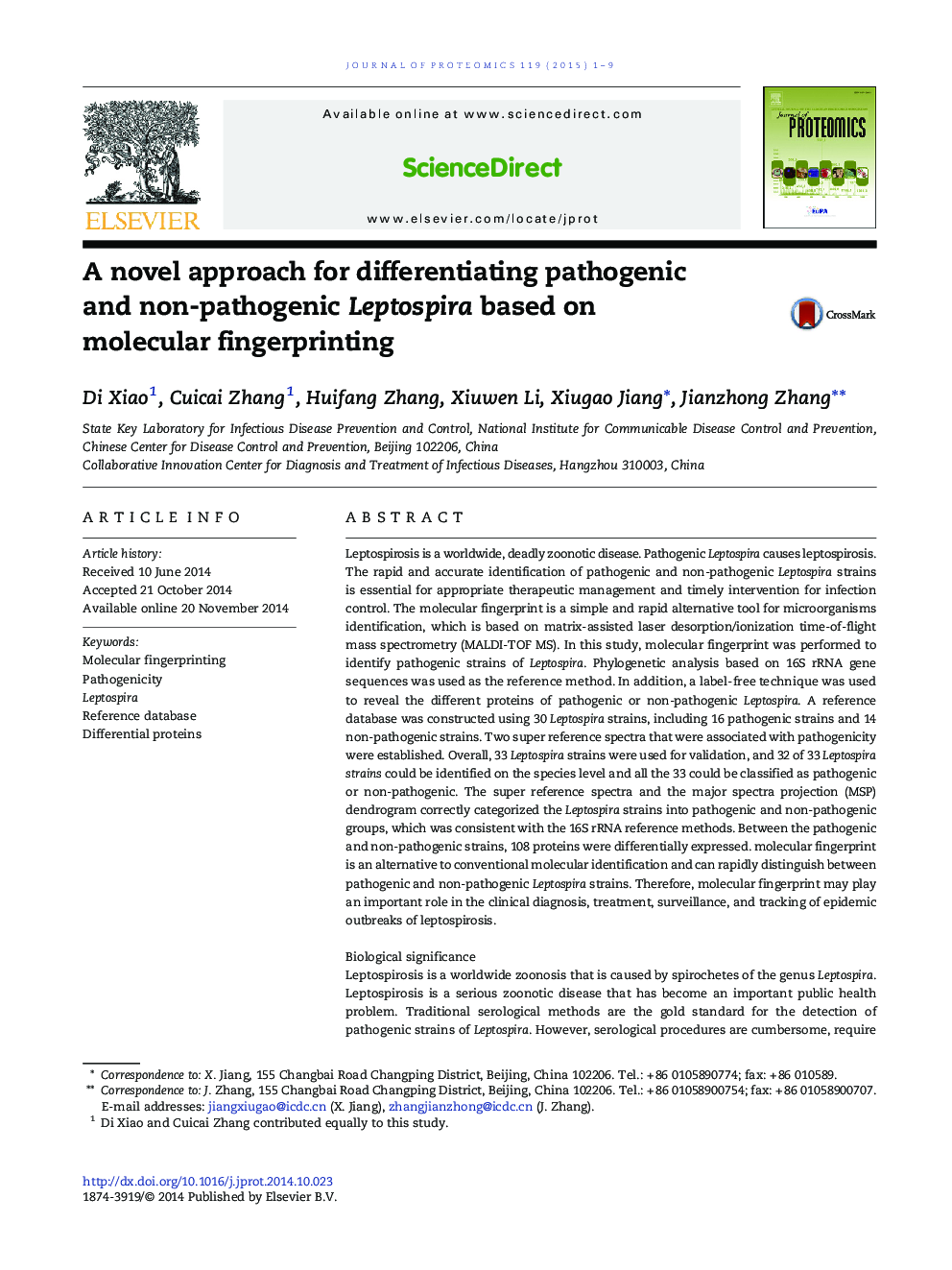| کد مقاله | کد نشریه | سال انتشار | مقاله انگلیسی | نسخه تمام متن |
|---|---|---|---|---|
| 1225362 | 1494761 | 2015 | 9 صفحه PDF | دانلود رایگان |
• The pathogenicity of Leptospira can be identified by molecular fingerprinting.
• Super reference spectra were introduced to distinguish pathogenicity of Leptospira.
• The differential proteins associated with pathogenicity Leptospira were revealed.
• Molecular fingerprinting can significantly reduce detection time and cost compared with other methods.
Leptospirosis is a worldwide, deadly zoonotic disease. Pathogenic Leptospira causes leptospirosis. The rapid and accurate identification of pathogenic and non-pathogenic Leptospira strains is essential for appropriate therapeutic management and timely intervention for infection control. The molecular fingerprint is a simple and rapid alternative tool for microorganisms identification, which is based on matrix-assisted laser desorption/ionization time-of-flight mass spectrometry (MALDI-TOF MS). In this study, molecular fingerprint was performed to identify pathogenic strains of Leptospira. Phylogenetic analysis based on 16S rRNA gene sequences was used as the reference method. In addition, a label-free technique was used to reveal the different proteins of pathogenic or non-pathogenic Leptospira. A reference database was constructed using 30 Leptospira strains, including 16 pathogenic strains and 14 non-pathogenic strains. Two super reference spectra that were associated with pathogenicity were established. Overall, 33 Leptospira strains were used for validation, and 32 of 33 Leptospira strains could be identified on the species level and all the 33 could be classified as pathogenic or non-pathogenic. The super reference spectra and the major spectra projection (MSP) dendrogram correctly categorized the Leptospira strains into pathogenic and non-pathogenic groups, which was consistent with the 16S rRNA reference methods. Between the pathogenic and non-pathogenic strains, 108 proteins were differentially expressed. molecular fingerprint is an alternative to conventional molecular identification and can rapidly distinguish between pathogenic and non-pathogenic Leptospira strains. Therefore, molecular fingerprint may play an important role in the clinical diagnosis, treatment, surveillance, and tracking of epidemic outbreaks of leptospirosis.Biological significanceLeptospirosis is a worldwide zoonosis that is caused by spirochetes of the genus Leptospira. Leptospirosis is a serious zoonotic disease that has become an important public health problem. Traditional serological methods are the gold standard for the detection of pathogenic strains of Leptospira. However, serological procedures are cumbersome, require more complex experimental techniques, and are based on a large number of international and domestic reference strains. Additionally, these experiments involve the immunization of animals with antigens from different serotypes to produce immune serum, and improper techniques may result in a rapid decrease in antibody titer, which would affect the final results. It is difficult to perform cumbersome detection procedures in a basic laboratory. Therefore, the use of conventional serological methods is limited, which significantly impacts daily leptospirosis epidemic surveillance, prevention, and control. Molecular biology methods, such as 16S rRNA and PCR-based methods, can be used to identify the pathogenic Leptospira. However, DNA extraction and gene sequencing methods are laborious and time consuming. Therefore, more rapid and reliable high-throughput identification methods are urgently needed for the clinical diagnosis of leptospirosis to improve epidemic control. Here, molecular fingerprinting technique was use to identify the pathogenicity. We constructed the reference spectra database and the super reference spectra of pathogenic and non-pathogenic Leptospira, which can rapidly identified Leptospira at the species level and the pathogenicity of these isolates can be simultaneously confirmed. Furthermore, the protein components of Leptospira pathogenicity were revealed. These findings thus provide a new way for Leptospira pathogenicity identification.
Figure optionsDownload high-quality image (100 K)Download as PowerPoint slide
Journal: Journal of Proteomics - Volume 119, 24 April 2015, Pages 1–9
